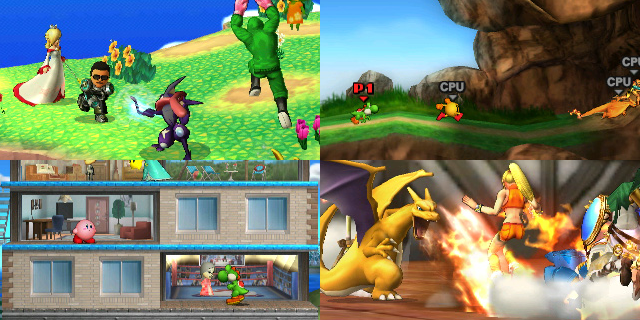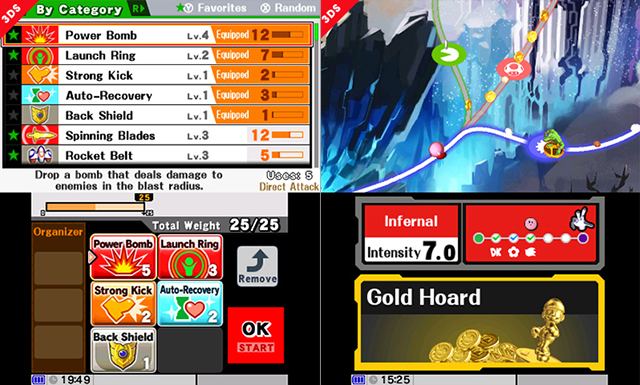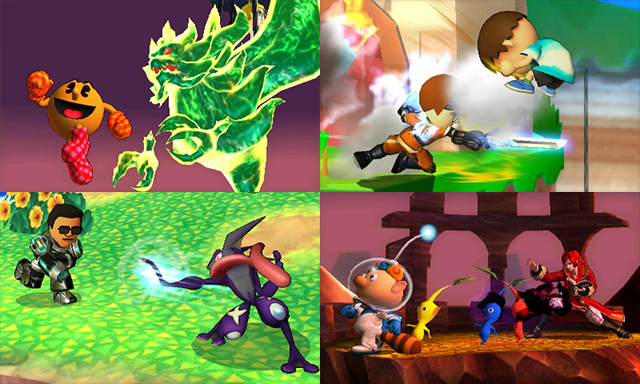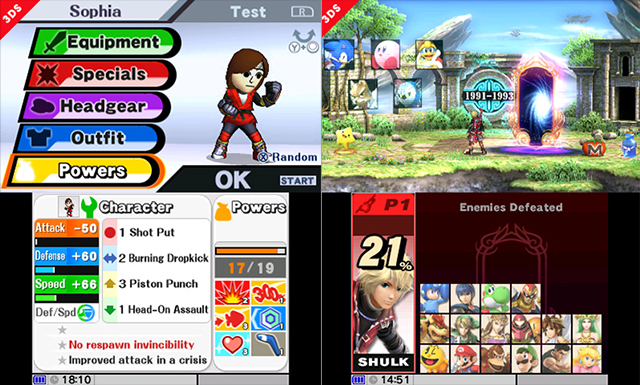
Until this point, the Super Smash Bros. series has been almost entirely defined by its local multiplayer experience. Sure, there have been single-player modes, and sure, Brawl had online play, but the true focus has always been on jumping in and battling it out with a friend or three on the couch. Almost out of necessity, this new 3DS entry of Super Smash Bros. shifts that focus to something more personal, something more customized and about reaching goals on your own.
 This review was written based on the Japanese release of Super Smash Bros. for Nintendo 3DS. If the North American release contains notable differences, we will update accordingly.
This review was written based on the Japanese release of Super Smash Bros. for Nintendo 3DS. If the North American release contains notable differences, we will update accordingly.For those who haven’t kept up with the game’s development, the two Super Smash Bros. games releasing this fall have been developed simultaneously and contain identical rosters (and some sort of connectivity features we’ll learn about later), but they aren’t the same game. Each has its own suite of stages, as well as a smattering of exclusive modes. For the 3DS, this generally means Smash Run, a mode I’ll talk about later, and levels that focus on small screens, both in the franchise sense (Tomodachi Life and Nintendogs) and in one of scale (areas like Melee and Brawl‘s Temple wouldn’t make sense). Even without the more sprawling arenas, 3DS‘ stage selection offers a lot of variety, as well as the opportunity to explore lesser-treaded venues in Nintendo’s IP catalog.
The largest difference clearly lies in the controls. The 3DS does an admirable job of trying to recreate the Smash experience with a Circle Pad and fewer buttons (until the New 3DS releases, anyway), but die-hards now practically glued to GameCube controllers will likely need some time to adjust. After all, the Circle Pad just doesn’t “smash” like an analog stick does, and long action game sessions are going to tire out 3DS-holding hands faster than controller-wielding ones. Still, this 3DS version wasn’t made for playing for hours on end, as much as many buyers will be doing just that until its big brother hits store shelves.

StreetPass diversions
Smash 3DS‘ StreetPass functionality isn’t particularly special; the logical sorts of things are likely being saved for the Amiibo launch later this year. What’s left amounts to a table game, in which you’re trying to knock everyone else off by charging and propelling your little character symbol at opponents. At least it’s a way of generating coins and gaining items to use to get trophies and such.
The final thing you’d expect to be featured heavily in the 3DS version is the 3D itself. Smash Bros. is played on a horizontal plane, so there’s not much that changes with the game itself when depth is added, but the environments do look very nice with the added perspective. There are also the small things, as you’d expect from the series; after all, even back in the GameCube days, the character select screen was rendered with dimension and dynamism.
Even on a smaller screen and with less power, Smash looks great in motion. It runs at a smooth 60 frames per second, and there’s certainly never a perceived lack of detail. Even with smaller environments, though, action on the screen can get small. It’s easier to keep up with when you’re actually playing than as a spectator, but you’ll find yourself off the screen or in a pile of dust more often than in previous titles. Thankfully, the idea of using iconic characters means they’re all fairly easy to discern at a small size. (There are exceptions, though; for example, yellow Kirby and Pac-Man are very similar, and many characters have similar-looking alternate costumes.

Angry Bros.
Joining the traditional Home Run Contest in this edition is Target Blast, which has you damaging a bomb in a similar way, then launching it at an Angry Birds-style structure of blocks and targets with the hopes of destroying as many pieces as possible. There’s a bit more to this than just getting the most powerful hit with a bat, though it’s admittedly bizarre that a game with such reverence for Nintendo lore would borrow from outside sources for new challenges.
The 3DS version’s big exclusive mode, Smash Run, is inspired by the City Trial mode of Kirby Air Ride, a game that met a mixed reception but that we like quite a bit. In both games, you wander around a large arena, gathering stat boosts and power-ups while preparing for a largely-random event that begins when time runs out. Ultimately, it feels like it works better in Air Ride than it does here, simply because gliding about on a star is more fun than wandering around environments alone using Smash controls for platforming action. Still, it picks up when encountering other players, and there will definitely be expert-level strategies to finding the optimal run. That is, if the mode manages to gather enough interest despite lacking online play.
What is available online is mostly limited to standard matches, which is probably for the best, as it keeps things simple and helps with matchmaking. As with many Nintendo online titles, you can choose to either play with friends or take on random opponents either from your region or worldwide. Given the connection capabilities of the 3DS, you’re likely better off sticking to your own region when possible, as the game’s definitely susceptible to lag and stuttering, and it occasionally even pops up when playing locally (though not enough to matter much).

How you’ll likely spend most of your time in Smash 3DS is utilizing its deep, compelling customization features. You can make a Mii from scratch and equip it with gear and moves, or you can tweak the parameters of existing characters. There are lots and lots of parts here to unlock, and they’ll be flowing long after you’ve unlocked the full roster, as each alternate move, each hat, each badge and each costume must be acquired separately.
Sure, you can make your friends or weird items, but this system is also used as a way to create (or re-implement) clone characters of your own. For example, fans sad that Wolf isn’t returning can come very, very close by taking Fox’s Wolf-like color scheme and equipping move variations and stat tweaks. Also, why not take Peach’s Daisy-like colors, put a whole new repertoire on her and making a truly new-feeling fighter with a distinctive look? There are more opportunities for this (especially in the unlockable segment of the roster), but even if that’s not your thing, there’s probably a little-used move on your favorite character you’ll want to try swapping out for something different.
For a game clearly destined to become a little brother to the Wii U release, Super Smash Bros. for Nintendo 3DS does what it can to justify itself while managing to stand alone for those who have yet to take the plunge on Nintendo’s home console. Don’t get us wrong — you’ll still want to play the Wii U version with friends when you have the option — but when you’re on the go, you’ll find that the portable entry is more than worth your time.
Pros: Exclusive modes, character customization, smart focus on small-scale levels
Cons: Smash Run could be better-paced, on-screen action can get quite tiny



















